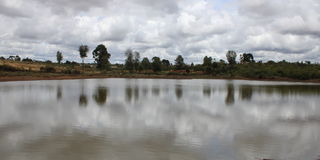The curse of Nyandarua killer dams

Kimani dam on the Nyandarua-Laikipia county border, where tens of residents have died by suicide and in accidents.
When the residents of Muthiga village and the neighborhood were settled by the government in 1973, they inherited two critical assets — dams that were a blessing to the new land owners — from colonial settlers.
The government bought the farms to settle landless Kenyans from all over the country in the sprawling farms connecting Laikipia and Nyandarua counties, though the better part of the settlement is within Nyandarua.
From those days until the 1980s, the dams were the pride and joy of the residents, bringing glory to Muthiga village and its neighbours.
The dams were built by the colonial settlers who specialised in livestock farming and irrigation in the areas then known as Mbuyu Laikipia and Mbuyu Nyandarua, but Kiboko Dam and Kimani Dam are about 400 metres apart.
The two Mbuyus were owned by different colonial settlers — Mr Don Smith and a Mr Gordan, each with a dam.

Cows drink water at killer Kiboko dam in Muthiga Village, Nyandarua, where a mother and four daughters drowned in a successful suicide mission.
However, the two dams, which were a blessing to the community, have now become bloodthirsty water bodies, and death traps, characterised by either suicides or accidents.
Smith’s dam was christened Kimani Dam after a resident, James Kimani, died in it, while Gordan's dam was christened Kiboko due to hippos living there that terrorised the residents.
Tens of American tourists used to visit the dams for bird watching.
“The Americans brought us a lot of gifts, they gave us money, some of them paid school fees for the bright children. The dam has very clean and clear water that we used as a mirror. Today, the dams cause us more tears than joy, they are a death trap,” said Ms Abagail Wanjiku, who lives near Kiboko dam.
The residents have lost count of the number of deaths in the dams, but recall the worst incident about 10 years ago when a mother killed her four daughters and herself in Gordan dam following a quarrel with her husband. One of the latest incidents involves a man identified as James Chesang, who jumped into the water and died after he differed with his girlfriend.
Chesang’s death was followed by the accidental death of Deng Njogu, who was trying to rescue a woman who slipped into the water as she fetched water.
“The lady slipped while fetching water, but she was able to balance herself for about 30 minutes when the young man arrived and rescued her. He rescued the lady and decided to go back for the plastic container, that is when he got stuck in the mud and died. His body was stuck in the mud about seven feet deep,” said Mr Joseph Kahiga, a diver who has been involved in most of the rescue and recovery missions in the two dams.
About three weeks ago, Mr Kahiga and his divers rescued three children in Kimani dam and he explained how the dam’s name changed from Don Smith Dam to Kimani Dam.
“Kimani stopped by the dam and decided to swim. He removed his clothes, placed them under an acacia tree, and dived into the waters, that was the last time he was seen alive, and he was the first casualty years ago. We tried tracing his body in vain. The villagers visited the dam every morning for a week, saying they were going to find Kimani, and that is how it was named Kimani dam, his body floated a week after he was swallowed by the water,” said Mr Kahiga.
Mr Uniki Mungai, a former manager at the Smith farm said the deaths started in the 1970s after the current land owners were allocated the land, but they have increased with time.
“I don’t remember us having any deaths in the dams, not even those of livestock when the dams were owned by the settlers. I can say that apart from suicides, most other deaths are caused by people getting stuck in the mud. The dams need desilting, they are constructed on black cotton soil, which is very sticky, one gets fully stuck when trying to pull out the first stuck leg. The dams are never maintained by removing the mud like was the case when they were settler-owned,” said Mr Mungai.

Mr Joseph Kahiga, a diver, speaks to a journalist about the number of rescues he has carried out and bodies he has helped pull out of Kimani dam on the Nyandarua-Laikipia county border.
His sentiments are shared by a village elder, Mr Charles Munene, who said each of the dams had more than 70-acres around it, most of which have been grabbed.
“The dams are sticky with mud. In those days, the environment was very conducive, there were a lot of wild animals, including elephants, hippos, and buffalos, living in the bushes. They came to drink water from the two dams, none of them ever got stuck or died, and the dams were well maintained. But agricultural activities, the felling of trees, and the grabbing of riparian lands have resulted in massive soil erosion into the dams. This mud needs to be removed, the dams fenced and some areas installed with drinking points for livestock,” said Mr Munene.
If rehabilitated, the dams can help local farmers in dry areas.
“If the stolen dam land is repossessed and the dams rehabilitated, they can supply enough irrigation water for the farmers in the dry lower part of Ndaragua, including Kwa Don village, Muthiga, Umoja Mbuyu and part of the neighbouring Laikipia county, where residents also rely on Kiboko dam in Muthiga village and Kimani dam on the Laikipia-Nyandarua county border,” said the farmer.





